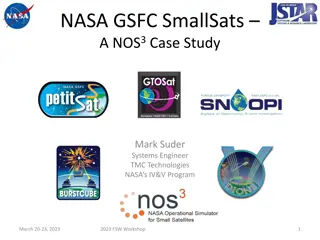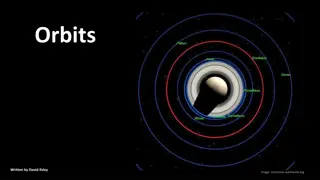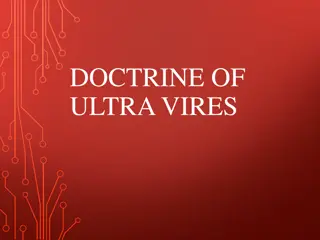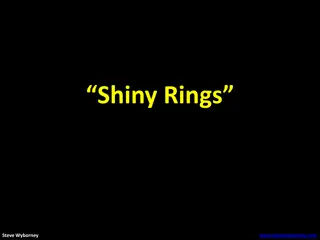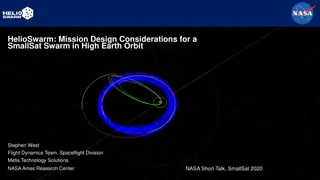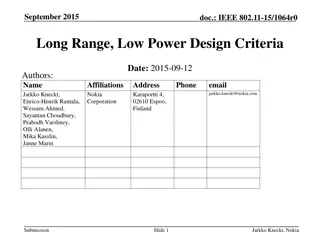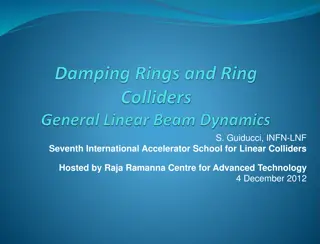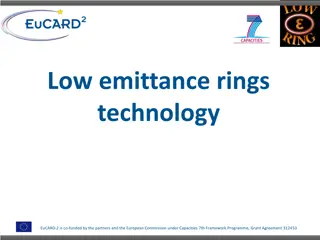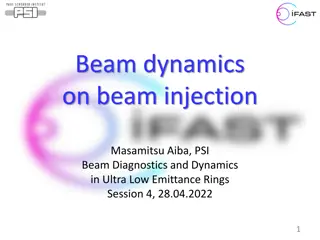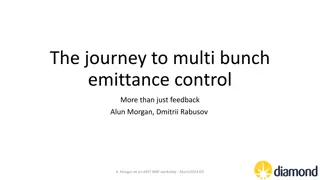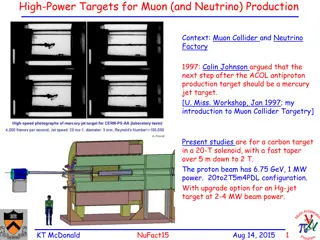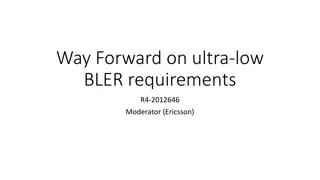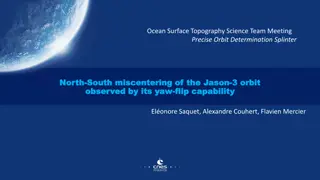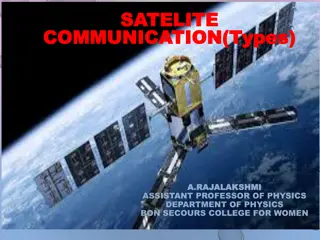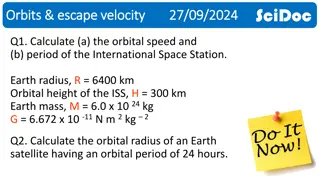Ideal Orbit Feedback for Ultra-low Emittance Rings Workshop Summary
The workshop on Ideal Orbit Feedback for Ultra-low Emittance Rings by Guenther Rehm at CERN in January 2018 covered topics such as Orbit Feedback Motivation, Bandwidth, Latency, Control Techniques, and References for further reading. The presentation highlighted the importance of precise beam position monitoring, feedback control systems, and the impact of small-scale dipole deviations on orbit stability in particle accelerators.
- Ideal Orbit Feedback
- Ultra-low Emittance Rings
- Workshop Summary
- Particle Accelerators
- Control Techniques
Download Presentation

Please find below an Image/Link to download the presentation.
The content on the website is provided AS IS for your information and personal use only. It may not be sold, licensed, or shared on other websites without obtaining consent from the author. Download presentation by click this link. If you encounter any issues during the download, it is possible that the publisher has removed the file from their server.
E N D
Presentation Transcript
Ideal Orbit Feedback for Ultra-low Emittance Rings Guenther Rehm 7thLow Emittance Ring Workshop CERN, 15-17 Jan 2018
Outline The Motivation of Orbit Feedback Bandwidth and Latency Simple Feedback and Internal Model Control Whole Orbit Control Orbit Response Matrix Inversion Summary 7th Low Emittance Workshop, CERN, 15-17 Jan 2018: Ideal Orbit Feedback for Low Emittance Rings, G. Rehm 2
References and further reading Overviews: [1] Aug. 2005. [2] [3] J. Bechhoefer, Feedback for physicists: A tutorial essay on control, Rev. Mod. Phys., vol. 77, no. 3, pp. 783 836, A. Chao et.al., Handbook of Accelerator Physics and Engineering , pp. 624-628, World Scientific, 2013, 2nd Ed. D. Bulfone, Overview of Fast Beam Position Feedback Systems, in Proc. of EPAC, 2008, pp. 1021 1025. Details: [4] [5] of ICALEPCS, 2015, pp. 494 497. [6] N. Hubert, et al. "Global orbit feedback systems down to DC using fast and slow correctors," in Proc. ofDIPAC, 2009. [7] A. Terebilo, et.al. "Fast global orbit feedback system in SPEAR3." Proc. ofEPAC, 2006. [8] S. Duncan, The Design of a Fast Orbit Beam Stabilisation System for the Diamond Synchrotron , report 2296/07, Oxford University P. Kallakuri et.al., Modelling the Fast Orbit Feedback Control System for APS Upgrade, in Proc. of IBIC2017, 2017. S. Gayadeen, et. al. , A Unified Approach to the Design of Orbit Feedback with Fast and Slow Correctors, in Proc. PhD Thesis [8] [9] R. Steinhagen, LHC Beam Stability and Feedback Control, RWTH Aachen, 2007. S. Gayadeen, Synchrotron Electron Beam Control, University of Oxford, 2014. 7th Low Emittance Workshop, CERN, 15-17 Jan 2018: Ideal Orbit Feedback for Low Emittance Rings, G. Rehm 3
A bit of Feedback Language Monitor: Beam Position Monitor, Orbit Actuator: Corrector Magnets including their power supplies Plant, Process: The controlled equipment, for us the stored beam orbit Controller: The control algorithm and its implementation Latency: Various delays like transport delays, calculation delays Transfer function: complex model of Out/In, a function of ? = ?? SISO: Single Input Single Output MIMO: Multi Input Multi Output Mode: a spatial orbit pattern ?1 ?2 = 20 log10 ?1 ?2 dB: a unit of log power ratio defined 10 log10 7th Low Emittance Workshop, CERN, 15-17 Jan 2018: Ideal Orbit Feedback for Low Emittance Rings, G. Rehm 4
The Source of Orbit Deviations Small scale dipole deviation will create an orbit deviation of the shape: From [2] The sin???/? term in the denominator acts as a scaler to ALL orbit deviations 7th Low Emittance Workshop, CERN, 15-17 Jan 2018: Ideal Orbit Feedback for Low Emittance Rings, G. Rehm 5
The Goal of Orbit Feedback To keep the orbit of the stored beam in a storage ring within: specified deviations Typically 10% of RMS beam size is allowed as RMS motion Only useful if integrated over by the experiment (talk to users), otherwise aim at 2-3% Must be accompanied by range, order of 1mHz 1000Hz from desired positions First aim is beam based alignment centre of nearby quadrupole Needs to be reliable thereafter, minimise electrical and mechanical drifts (cables, electronics, temperature, foundations etc.) In light sources, photon beam position monitors might turn out to be more relevant longer term at all observed locations Betatron waves in both planes sufficiently spatially sampled (aim at 4 BPMs per period) Typically 100s of Beam Position Monitor (BPM) locations around the ring 7th Low Emittance Workshop, CERN, 15-17 Jan 2018: Ideal Orbit Feedback for Low Emittance Rings, G. Rehm 6
A simple feedback loop d(s) ?(s) From [1] G(s): Transfer function of the plant, including actuator and monitor dynamics (beam orbit including corrector and BPM dynamics) K(s): Transfer function of the controller e(s): feedback error r(s): set point u(s): actuator values (corrector magnet values) y(s): monitor values (BPM values) d(s): disturbance (here shown on the orbit, could equally be shown adding to u(s) ?(s): BPM uncertainties/noise 7th Low Emittance Workshop, CERN, 15-17 Jan 2018: Ideal Orbit Feedback for Low Emittance Rings, G. Rehm 7
If only the world was so simple 7th Low Emittance Workshop, CERN, 15-17 Jan 2018: Ideal Orbit Feedback for Low Emittance Rings, G. Rehm 8
BPM frequency response Almost all modern BPMs use finite impulse response (FIR) low pass filters This will cause systematic latency of generally half their length Sharper drops will cause longer latency, slower require higher output sample frequency Latency is visible as linear phase slope as delay causes ? ? T 7th Low Emittance Workshop, CERN, 15-17 Jan 2018: Ideal Orbit Feedback for Low Emittance Rings, G. Rehm 9
BPM technology evolution BPMs today are integrated with digitisation, often at high speed (>100MS/s), and subsequent averaging/filtering to lower speeds for orbit transfer. Choice of speed for orbit transfer depends on network technology, 2Gb/s is the past, 6.5Gb/s on current commercial equipment, 10+Gb/s are available without big complication. It is this speed and the update rate of orbit reading which will ultimately cause latency, thus aim as high as you can. 7th Low Emittance Workshop, CERN, 15-17 Jan 2018: Ideal Orbit Feedback for Low Emittance Rings, G. Rehm 10
Magnet and Vessel Transfer Functions Magnets slow down due to eddy currents in the joke, choose laminated, ferrite or air core for correctors. Vessels can show significant eddy currents effects for high conductivity material (Cu, Al). Simulations are required to estimate effects on geometries with cooling channels or other features attached 7th Low Emittance Workshop, CERN, 15-17 Jan 2018: Ideal Orbit Feedback for Low Emittance Rings, G. Rehm 11
Internal Model Control From [1] ? ? : Transfer function of the model, monitor and actuator dynamics and latency, provides predictions of plant behaviour Q(s): IMC controller This system is one way to explicitly address the significant latency as found in digital systems Solution for a simple 1-pole low pass model is straight forward and feature three parameters: latency, bandwidth and gain 7th Low Emittance Workshop, CERN, 15-17 Jan 2018: Ideal Orbit Feedback for Low Emittance Rings, G. Rehm 12
Latency, Bandwidth, Gain Increasing latency or decreasing bandwidth both limit performance (lower crossover of gain 1) Reducing gain also reduces performance, but differently Most importantly, this is the only parameter that remains to chose later 7th Low Emittance Workshop, CERN, 15-17 Jan 2018: Ideal Orbit Feedback for Low Emittance Rings, G. Rehm 13
SISO to MIMO, continuous to sampled In orbit feedback, we have multiple BPMs and multiple correctors. Controller needs to be a MIMO controller. But we get away with separation the static ORM and separate (initially identical dynamics) of all the modes. Also for digital controller design, we need to consider a sampled system. Matrix inversion of the ORM is required in the controller and done using SVD: ? = ???? ?+= ?? 1?? Works for non-square ORM just as well. ? ?? From [8] 7th Low Emittance Workshop, CERN, 15-17 Jan 2018: Ideal Orbit Feedback for Low Emittance Rings, G. Rehm 14
Orbit Response Matrix 7th Low Emittance Workshop, CERN, 15-17 Jan 2018: Ideal Orbit Feedback for Low Emittance Rings, G. Rehm 15
Inverse Orbit Response Matrix 7th Low Emittance Workshop, CERN, 15-17 Jan 2018: Ideal Orbit Feedback for Low Emittance Rings, G. Rehm 16
Under the Hood of SVD 1 7th Low Emittance Workshop, CERN, 15-17 Jan 2018: Ideal Orbit Feedback for Low Emittance Rings, G. Rehm 17
Under the hood of SVD 2 7th Low Emittance Workshop, CERN, 15-17 Jan 2018: Ideal Orbit Feedback for Low Emittance Rings, G. Rehm 18
Singular Values The singular value matrix is diagonal, so inversion simply requires inverting the individual elements However, with poorly conditioned matrices this strongly emphasises high modes 7th Low Emittance Workshop, CERN, 15-17 Jan 2018: Ideal Orbit Feedback for Low Emittance Rings, G. Rehm 19
Beam Motion in Mode Space Most orbit disturbance happens in first few modes of ORM! Graphs below are produce from 80s (averaged over 1s FFTs) of actual whole orbit data without feedback 7th Low Emittance Workshop, CERN, 15-17 Jan 2018: Ideal Orbit Feedback for Low Emittance Rings, G. Rehm 20
Tikhonov regularisation Deals with inversion of poorly conditioned matrix, less severe than culling Replaces inversion of singular values with ???= ??? ? = ? ?? Regularisation parameter ? will chose strength of calming high modes, but they are not eliminated After multiple applications, the result will still be a fully corrected orbit With IMC controller, ? will cause lower gain for high modes Requires only adaptation of ORM inversion, reduces pickup of electronic noise from BPMs ??? 2 +?2 7th Low Emittance Workshop, CERN, 15-17 Jan 2018: Ideal Orbit Feedback for Low Emittance Rings, G. Rehm 21
Tikhonov regularised inverted ORM, ? = 1 ? = ? ?? 7th Low Emittance Workshop, CERN, 15-17 Jan 2018: Ideal Orbit Feedback for Low Emittance Rings, G. Rehm 22
Tikhonov regularised inverted ORM, ? = 10 ? = ? ?? 7th Low Emittance Workshop, CERN, 15-17 Jan 2018: Ideal Orbit Feedback for Low Emittance Rings, G. Rehm 23
Mode by Mode Orbit Control (MoMOC) Even more capable in adapting to actual orbit distortion in mode space, one controller (PID, IMC, higher order, adaptive) Design would choose a suitable control parameters per mode! This might be optimal control or even predictive control. Resulting orbit motion and required corrector action will be minimized Today s commercial FOFB in use at MAX-IV, Soleil, TPS, ASLS have facilities for different PID per mode realised in FPGA! APS-U has presented prototype of DSP based design of similar capabilities. 7th Low Emittance Workshop, CERN, 15-17 Jan 2018: Ideal Orbit Feedback for Low Emittance Rings, G. Rehm 24
How to build the ideal fast orbit feedback Keep tunes as close to half integer as possible Reduce excitation as far as possible (foundation, girders, water cooling) Estimate, calculate and measure bandwidth and latency of all components Choose fastest transport network on the market (10+Gb/s) Choose BPMs with high sample rate (100-200kS/s, or turn-by-turn) Bring all data to one compute node with enough power If it saves much time, repeat computations in many locations Implement modern control on DSP or FPGA, keep maintenance in mind Distribute corrector data through same or similar network Use power convertors designed, built and tested for bandwidth and low latency Use fast corrector magnets (laminated or ferrite) over thin, low conductivity vessels (thin stainless or Inconel) to reduce eddy currents If not all correctors can be fast, modern control algorithms can deal with that in one calculation Finally, low synchrotron frequency might cause interaction with RF cavity feedback! 7th Low Emittance Workshop, CERN, 15-17 Jan 2018: Ideal Orbit Feedback for Low Emittance Rings, G. Rehm 25
Acknowledgements Diamond Light Source: J. Rowland, M. Abbott, S. Gayadeen, M. Heron, T. Dobbing, I. Martin, R. Bartolini Oxford University: S. Duncan Other Light Sources: M. B ge (SLS), M. Lonza (Elettra), E. Plouviez, J.-M. Koch (ESRF), J. Carwardine (APS) 7th Low Emittance Workshop, CERN, 15-17 Jan 2018: Ideal Orbit Feedback for Low Emittance Rings, G. Rehm 26
Announcement Topical Workshop on Diagnostics for Ultra Low Emittance Rings (TW-DULER) Supported by the ARIES European project, under the Ring with Ultra Low Emittance (RULE) work package coordination: Synchrotron SOLEIL and Diamond Light Source are organizing a: Topical Workshop on Diagnostics for Ultra Low Emittance Rings 19-20 April 2018 Diamond Light Source Scientific Program Committee: L. Nadolski (Synchrotron SOLEIL) N. Hubert (Synchrotron SOLEIL) R. Bartolini (Diamond Light Source) G. Rehm (Diamond Light Source) B. Hettel (APS) H. Schmickler (CERN) J. Urakawa (KEK) P. Kuske (Bessy) A. Andersson (Max-IV)


![[PDF⚡READ❤ONLINE] Neptune: The Planet, Rings, and Satellites](/thumb/21522/pdf-read-online-neptune-the-planet-rings-and-satellites.jpg)
